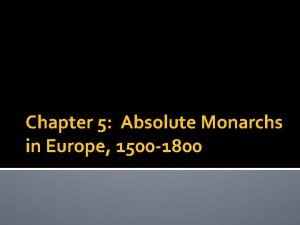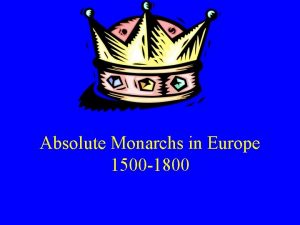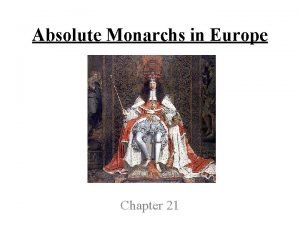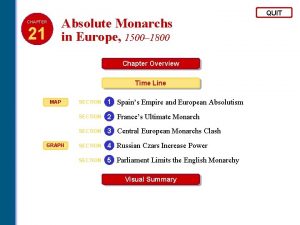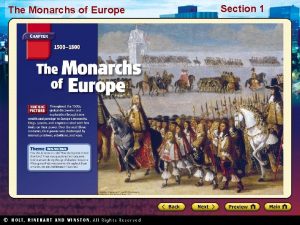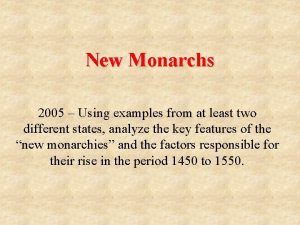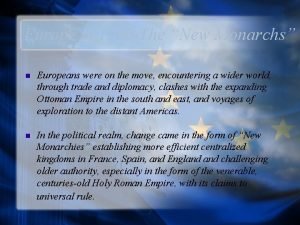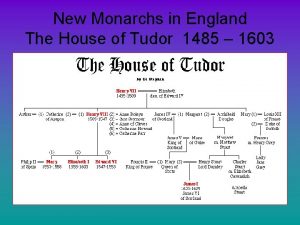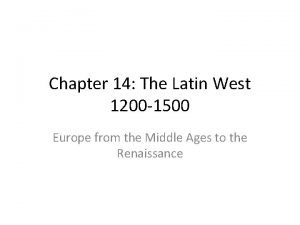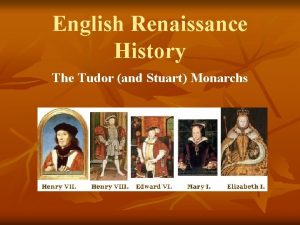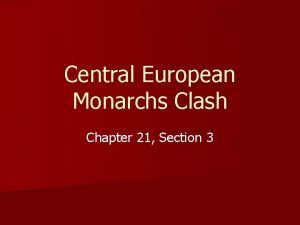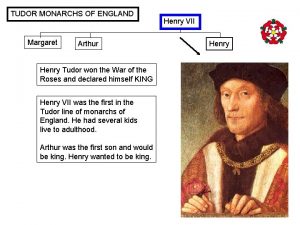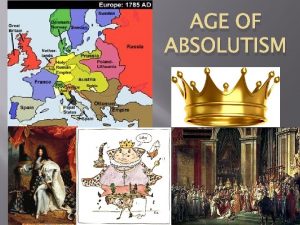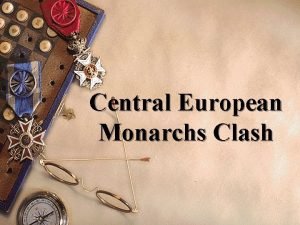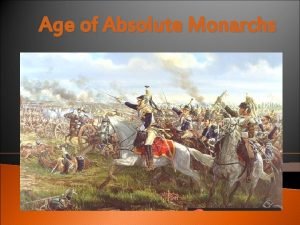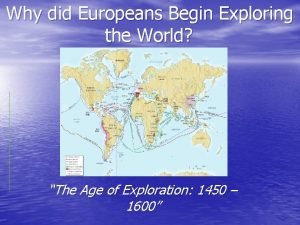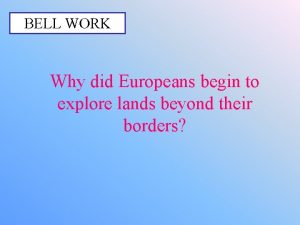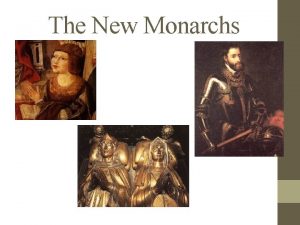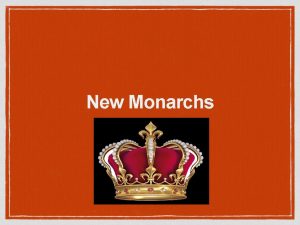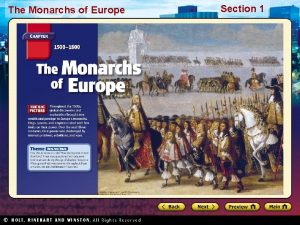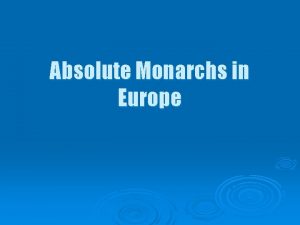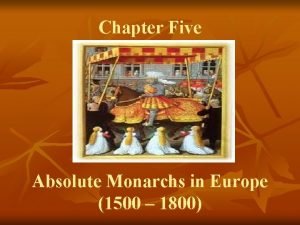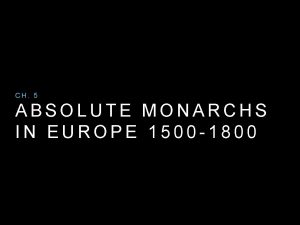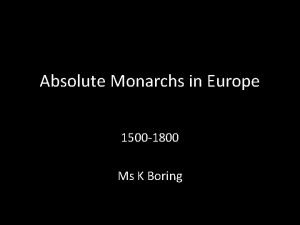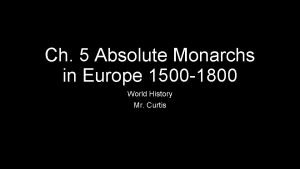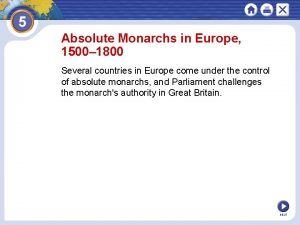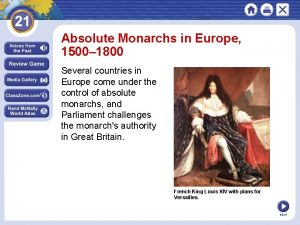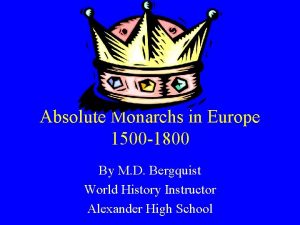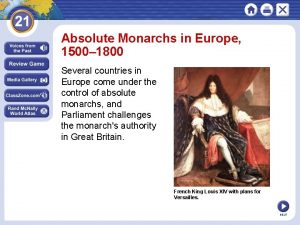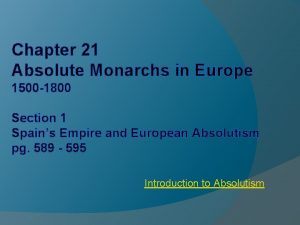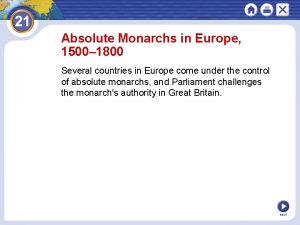Europe in 1500 The New Monarchs n Europeans






















- Slides: 22

Europe in 1500 -The “New Monarchs” n Europeans were on the move, encountering a wider world, through trade and diplomacy, clashes with the expanding Ottoman Empire in the south and east, and voyages of exploration to the distant Americas. n In the political realm, change came in the form of “New Monarchies” establishing more efficient centralized kingdoms in France, Spain, and England challenging older authority, especially in the form of the venerable, centuries-old Holy Roman Empire, with its claims to universal rule.

Changing Europe In the Middle Ages Monarchs governed in a highly decentralized way. They relied on their Barons or other great nobility for military service. n Taxes, most laws, and courts were mostly locally controlled. n But this began to change in the 16 th century. n

A new kind of state began to appear around 1450: The “New Monarchy. ” n Monarchs built on earlier foundations to achieve more centralized and efficient rule, absorbing formerly independent vassal lands under the crown. Now, the Monarch became the primary source of authority. n New bureaucracies and new armies were part of the consolidation and increasingly a monopoly on the use of force n This evolution was slow and uneven, but over time, these new monarchies became the basis of later “nation-states. ”

The New Monarchs waged a new kind of War Infantry, using gunpowder and pikes from the early 14 th century on, revolutionized the battlefield and downgraded noble cavalry, with serious social implications. n These changes ended chivalry on the field and transformed the art of fortification. Armies not only became larger, they became professional-- they were hired and paid for. No longer did they fight because of some feudal obligation. That meant they had to be paid for. The enormous new costs of changing warfare (in weaponry, scale, and organization) helped drive the formation of new monarchies.

France’s “New Monarchy” came as a response to the Hundred Years War n The Valois family had contended with English monarchs in the Hundred Years’ War (1337– 1453) and created a consolidated monarchy in its aftermath. n King Louis XI, “the Spider” (r. 1461– 1483 whose 22 -year reign was marked by political machinations. Louis is known to have been shrewd and often vicious. In curbing the power of the dukes, he re-established the power of the monarchy.

France’s “new monarchs” n n Charles VIII (1483– 1498) and Louis XII ( 1498– 1515) sought further expansion of power in a series of Italian wars. But it was King Francis I (1515– 1547) embodied the new monarch ideal:

King Francis I --France's first Renaissance monarch. Francis became a major patron of the arts and lent his support to many of the greatest artists of his time and encouraged them to come to France, including Leonardo da Vinci, who brought with him many of his great works, such as the Mona Lisa. Not only did Francis support a number of major writers of the period, he was a poet himself, and he set an important precedent by opening his library to scholars from around the world in order to facilitate the diffusion of knowledge. Francis rebuilt the Louvre, transforming it from a medieval fortress into a building of Renaissance splendor.

King Francis I, “New Monarch” Militarily and politically, Francis's reign was less successful, but his actions nonetheless illustrate the approach of the “new monarchs”. He spent a great deal of money-to no great effect in the end-- on a professional army to defeat his sworn enemy, the Holy Roman Emperor Charles V. To get the money for this and other projects he needed an efficient bureaucracy and tax collecting apparatus. So he made French the administrative language of the kingdom, replacing Latin, and required priests to register births, marriages and deaths and to establish a registry office in every parish. This established the first ongoing records of vital statistics available in Europe.

The Spanish Kingdoms n n Castile was the most powerful state in Europe in 1500, with a vast New World empire and famous infantry forces. While not as modernizing as France, Spain’s divided kingdoms had been drawn together in an uneasy alliance by the 1469 marriage of Isabella of Castile (1474– 1504) and Ferdinand II of Aragon ( 1479– 1516). Spanish Catholic kings were fired by a crusader impulse, expressed in the Reconquista and overseas conquest. Modern Spain was created. A crucial dynastic marriage in 1496 tied the Spanish throne to the Hapsburg family of Austria.

The Tudors consolidate England, Scotland Ireland to create Britain. After the internal strife of the War of the Roses (1455– 1485), the Tudor dynasty was established by a new monarch, Henry VII. His son Henry VIII (r. 1509– 1547) revolutionized government and created the Church of England, as the English realm was declared an empire under his control. This consolidation of authority would continue under the long reign of Queen Elizabeth (r. 1558– 1603). The crowns of Scotland England were united in 1603, creating a unit commonly referred to as “Britain. ” And, the Tudors began to colonize Ireland, which soon became an unwilling part of this new centralized Britain.

Not a “New Monarchy”--The Holy Roman Empire The origins of this loose confederation of principalities, After the year 1438, the elective title of emperor was held almost uninterruptedly in the family of Habsburg the “House of Austria. ” Habsburg emperors internalized a strong sense of mission, encapsulated in the mysterious motto, “AEIOU: Alles Erdreich Ist Österreich Unterthan, ” a rather immodest claim that all the world is subject to Austria. The Habsburgs were astute at the diplomacy of marriage, which resulted in a huge empire duchies, and kingdoms in German speaking areas and elsewhere went back to the emperor Charlemagne’s crowning in 800, as a revival of ancient Rome, but its power had declined in the High Middle Ages, including loss of control over Italy. The Holy Roman Empire was NOT united as a modern nation-state, but consisted of more than 300 states and units.

Maximilian I 1493 -1519, The “Last Knight” The marital diplomacy of this Holy Roman Emperor would have historic consequences that changed the age, leading to Habsburg control of Spain, Bohemia, Hungary, Burgundy, and the Netherlands under his grandson Charles V. Maximilian dreamt of a universal empire, and at the end of his life mused on becoming pope. painting by Albrecht Durer

The New Monarchs needed a new sort of advisor--a Courtier. n The old Monarch needed knights to help him fight wars. But the new monarch hired a professional army. But he needed educated advisors to help him figure out ways to collect more taxes and expand his empire. So one way a poor or middle class boy could rise in society was to get educated. Jean-Baptist Colbert was the financial wizard who advised Louis XIV.

Count Baldassare Castiglione Italian courtier and writer, was born near Mantua. In 1505, he was sent by the Duke of Urbino as envoy to Henry VII of England, who made him a knight, and was later Mantuan ambassador at the papal court in Rome (1513 -1524). His chief work, written in 1528 Il Cortegiano (The Courtier) was a manual for courtiers.

The Book of the Courtier n n n The Book of the Courtier describes the ideal court and courtier, going into great detail about the philosophical and cultured discussions that occurred at Urbino. The book defined the ideal Renaissance gentleman. In the Middle Ages, the perfect gentleman was a chivalrous knight who distinguished himself by his prowess on the battlefield. Castiglione's book changed that; now the perfect gentleman had to be educated in the classics as well. The book was soon translated into Spanish, German, French, and English, and 108 editions were published between 1528 and 1616.

The New Diplomacy n n. As states strengthened and interacted on a new plane of power, diplomacy likewise was being changed. n. Not only monarchs, but many other institutions such as the Church, cities and merchants’ associations sent envoys and representatives. n. At first ambassadors were not permanent or regular but were sent for special undertakings, often in groups, but the Italian city states began the practice of having permanent embassies, a model gradually adopted everywhere.

The 1533 painting, The Ambassadors, by Hans Holbein the Younger, is a mysterious and apt rendering of the diplomatic trade. http: //www. youtub e. com/watch? v=1 J m-AV 6 z. Ls. Y http: //employees. o neonta. edu/farbera s/arth 214/Amb assadors_Home. ht ml

Visits from foreign dignitaries -- real or imagined--were popular as subjects of painters.

n Louis XIV receives ambassadors from Siam.

The Field of the Cloth of Gold n In the early 16 th century, the powers in Europe were France, ruled by Francis I, and the Holy Roman Empire, led by Charles V. Henry VIII of England needed desperately to forge an alliance with one of the parties. In 1520, prompted by his chief advisor Cardinal Wolsey, Henry approached Francis I, and the two agreed on a meeting near Calais, between Guines and Ardres. The young kings, each considered paragons of monarchy in their respective countries, had long been rivals both personally and politically. n Thus, the kings set out to impress and outshine each other, arriving at the meeting with large retinues. In attempting to outshow the other, the kings spared no expense in their displays of wealth. They erected pavilions made with cloth of gold (real filaments of gold sewn with silk to make the fabric), organized jousts and other competitions of skill and strength, banqueted each other lavishly, in all ways trying to outdo and outspend one another. This ostentation earned the meeting the title "Field of the Cloth of Gold. "


The New Monarchs
 5 monarchs of europe
5 monarchs of europe Absolute monarchs in europe 1500-1800
Absolute monarchs in europe 1500-1800 Spain's empire and european absolutism chapter 21 section 1
Spain's empire and european absolutism chapter 21 section 1 Chapter 21 absolute monarchs in europe answer key
Chapter 21 absolute monarchs in europe answer key Chapter 5 absolute monarchs in europe
Chapter 5 absolute monarchs in europe New monarchs examples
New monarchs examples New monarchs examples
New monarchs examples The new monarchs
The new monarchs Renaissance europe 1500 map
Renaissance europe 1500 map Era medieval adalah
Era medieval adalah America africa and europe before 1500
America africa and europe before 1500 Tudor and stuart monarchs
Tudor and stuart monarchs Hapsburg triumphs
Hapsburg triumphs Chapter 21 section 3 central european monarchs clash
Chapter 21 section 3 central european monarchs clash Dr margaret henry
Dr margaret henry Age of absolute monarchs worksheet answer key
Age of absolute monarchs worksheet answer key Age of absolute monarchs
Age of absolute monarchs Central european monarchs clash
Central european monarchs clash Monarchs newbury park
Monarchs newbury park Bourbon absolutism
Bourbon absolutism Why did europeans begin exploring?
Why did europeans begin exploring? Lesson 1: europeans explore overseas
Lesson 1: europeans explore overseas Why did europeans begin to explore?
Why did europeans begin to explore?
